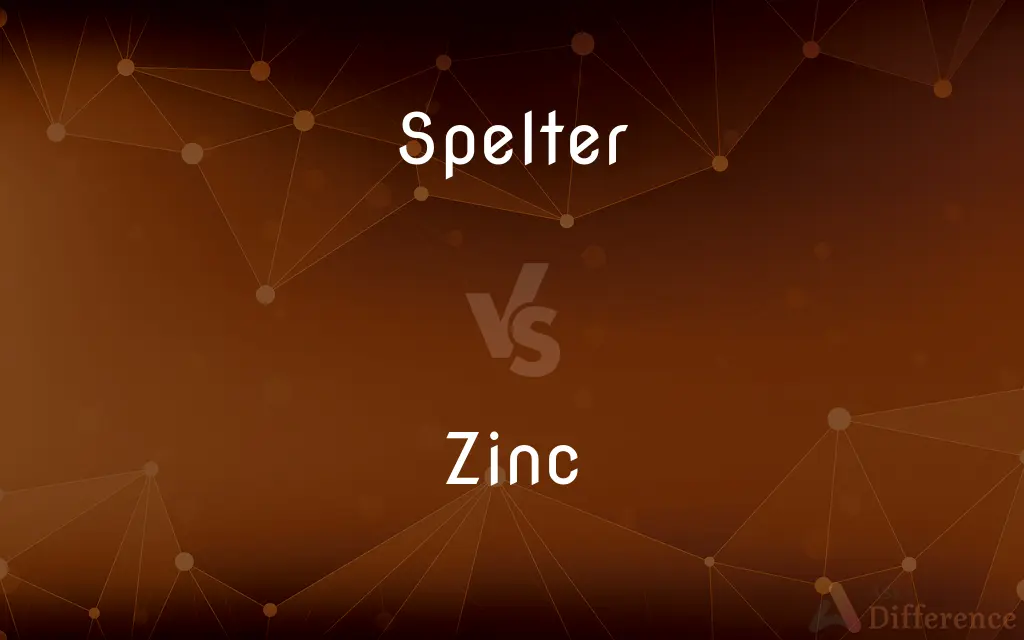Spelter vs. Zinc — What's the Difference?
By Tayyaba Rehman & Urooj Arif — Updated on April 8, 2024
Spelter refers to raw zinc or its alloys, often used in industrial and metallurgical contexts, while zinc is a chemical element (Zn) vital in various biological and industrial processes.

Difference Between Spelter and Zinc
Table of Contents
ADVERTISEMENT
Key Differences
Spelter is commonly associated with the raw form of zinc or its crude non-ferrous alloys, primarily used in industrial casting and metallurgical processes. On the other hand, zinc is a metallic element, distinguished by its symbol Zn and atomic number 30, and plays a crucial role in biological functions, corrosion resistance, and alloy creation.
In the metallurgical industry, spelter serves as a commercial term for zinc obtained from smelting, often implying a lower purity level suitable for certain industrial applications. Whereas, zinc in its pure form is highly sought after for its anti-corrosion properties and is extensively used in galvanizing iron and steel to protect against rust.
The term "spelter" sometimes also refers to the zinc dust used in painting and pigment production, highlighting its broader industrial utility. Zinc, however, is integral to human health as an essential trace element, supporting immune function and wound healing, showcasing its versatility beyond industrial use.
Spelter, being a more industrial-centric term, emphasizes the material's practical applications in manufacturing and metallurgy. Zinc focuses on the elemental and chemical properties that make it valuable in a wide range of contexts, from industrial to biological.
While spelter might be used in specific contexts to denote raw or alloyed zinc, zinc itself is a fundamental building block in numerous alloys, including brass, which combines copper and zinc to achieve enhanced properties such as increased strength, ductility, and corrosion resistance.
ADVERTISEMENT
Comparison Chart
Definition
Raw form of zinc or its crude alloys
A chemical element with symbol Zn
Primary Use
Industrial casting and metallurgy
Galvanization, alloying, and biological
Purity
Often lower, suitable for industrial applications
High purity for versatile applications
Context of Use
More industrial and metallurgical
Broad, including industrial and biological
Role in Alloys
Used in specific industrial alloys
Fundamental in creating various alloys
Compare with Definitions
Spelter
Used in paint production.
Spelter dust is a key ingredient in some industrial paints.
Zinc
Used in galvanization.
Galvanized steel is coated with zinc to prevent rust.
Spelter
Zinc alloys for industrial applications.
Spelter joints are commonly found in large metal structures.
Zinc
Metallic element, Zn.
Zinc is essential for human health, aiding in immune function.
Spelter
Lower-purity zinc product.
Spelter, due to its impurities, is cheaper than refined zinc.
Zinc
In dietary supplements.
Zinc supplements can help improve immune response.
Spelter
Term in metallurgical context.
Spelter soldering provides a cost-effective method for joining metals.
Zinc
Role in battery production.
Zinc is used in the anode of alkaline batteries.
Spelter
Raw zinc used in casting.
The foundry ordered a large shipment of spelter for their upcoming projects.
Zinc
Component of alloys.
Brass is an alloy of copper and zinc, known for its durability.
Spelter
Spelter is a zinc–lead alloy that ages to resemble bronze, but is softer and has a lower melting point. The name can also refer to a copper–zinc alloy (a brass) used for brazing, or to pure zinc.
Zinc
Zinc is a chemical element with the symbol Zn and atomic number 30. Zinc is a slightly brittle metal at room temperature and has a silvery-greyish appearance when oxidation is removed.
Spelter
Zinc, especially in the form of ingots, slabs, or plates.
Zinc
A bluish-white, lustrous metallic element that is brittle at room temperature but malleable with heating. It is used to form a wide variety of alloys including brass, bronze, various solders, and nickel silver, in galvanizing iron and other metals, for electric fuses, anodes, meter cases and batteries, and in roofing, gutters, and various household objects. US pennies minted after 1982 consist of a copper-clad zinc core. Atomic number 30; atomic weight 65.38; melting point 419.53°C; boiling point 907°C; specific gravity 7.134 (at 25°C); valence 2. See Periodic Table.
Spelter
(uncountable) zinc, often in blocks or ingot form.
Zinc
To coat or treat with zinc; galvanize.
Spelter
Zinc alloyed with another metal (especially copper), used as a solder.
Zinc
A chemical element (symbol Zn) with an atomic number of 30, a slightly brittle blue-silvery metal.
Spelter
(countable) An objet d'art made from zinc.
Zinc
(countable) A single atom of this element.
Spelter
To combine copper and metallic zinc to form an alloy.
Zinc
(Nigeria) A corrugated iron roof.
Spelter
Zinc; - especially so called in commerce and arts.
Zinc
A zinc countertop.
Zinc
(rare) To electroplate with zinc.
Zinc
(rare) To coat with sunblock incorporating zinc oxide.
Zinc
An abundant element of the magnesium-cadmium group, extracted principally from the minerals zinc blende, smithsonite, calamine, and franklinite, as an easily fusible bluish white metal, which is malleable, especially when heated. It is not easily oxidized in moist air, and hence is used for sheeting, coating galvanized iron, etc. It is used in making brass, britannia, and other alloys, and is also largely consumed in electric batteries. Symbol Zn. Atomic number 30. Atomic weight 65.38.
Zinc
To coat with zinc; to galvanize.
Zinc
A bluish-white lustrous metallic element; brittle at ordinary temperatures but malleable when heated; used in a wide variety of alloys and in galvanizing iron; it occurs as zinc sulphide in zinc blende
Common Curiosities
How is spelter different from zinc?
Spelter is typically less pure and used in specific industrial applications, while zinc refers to the pure metallic element, vital in various domains.
Where is spelter used?
Spelter is used in industrial casting, metallurgy, and sometimes in paint production.
Are spelter and zinc interchangeable terms?
In specific industrial contexts, they might be used interchangeably, but zinc is a broader term encompassing the element's various applications.
What is the role of zinc in batteries?
Zinc is used in the anode of alkaline batteries due to its reactivity and energy density.
What are the main uses of zinc?
Zinc's main uses include galvanization, alloy creation, and as an essential mineral in biology.
Why is zinc important?
Zinc is crucial for human health, corrosion protection, and as a component in many alloys.
Can spelter be used in dietary supplements?
No, spelter refers to industrial-grade zinc, not suitable for consumption.
What is spelter?
Spelter refers to the raw form of zinc or its crude alloys, often used in industrial settings.
What are the environmental impacts of zinc mining?
Zinc mining can lead to habitat destruction, water pollution, and soil contamination, underscoring the importance of responsible mining practices and recycling.
Is spelter the same as galvanized zinc?
No, spelter generally refers to raw or alloyed zinc, while galvanized zinc involves coating iron or steel with pure zinc for corrosion resistance.
Is zinc recyclable?
Yes, zinc is highly recyclable and can be reused in various applications without losing its properties.
How does the purity of spelter compare to that of zinc?
Spelter usually has a lower purity level compared to zinc, which is often refined to high purity for diverse applications.
Can spelter be used for galvanizing?
Yes, but it is less common due to its lower purity compared to refined zinc used for galvanizing.
How does zinc support human health?
Zinc supports immune function, wound healing, and is essential for numerous enzymatic reactions.
Why is zinc added to copper to make brass?
Zinc is added to copper to improve its strength, ductility, and corrosion resistance.
Share Your Discovery

Previous Comparison
Interval vs. Interlude
Next Comparison
Right vs. TitleAuthor Spotlight
Written by
Tayyaba RehmanTayyaba Rehman is a distinguished writer, currently serving as a primary contributor to askdifference.com. As a researcher in semantics and etymology, Tayyaba's passion for the complexity of languages and their distinctions has found a perfect home on the platform. Tayyaba delves into the intricacies of language, distinguishing between commonly confused words and phrases, thereby providing clarity for readers worldwide.
Co-written by
Urooj ArifUrooj is a skilled content writer at Ask Difference, known for her exceptional ability to simplify complex topics into engaging and informative content. With a passion for research and a flair for clear, concise writing, she consistently delivers articles that resonate with our diverse audience.














































